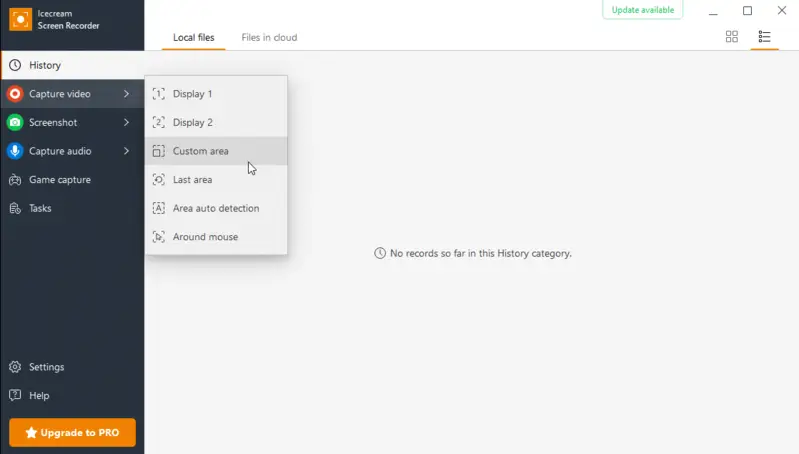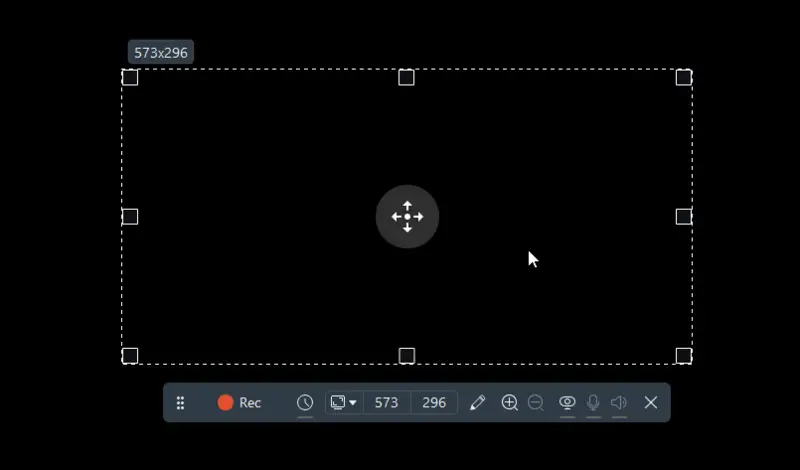What Is Screen Recording: The Basics
Screen recording comes in handy on many occasions and can be done on almost any device now. This article delves into the fundamentals of screen capture, exploring its usage, benefits, and the various software available.
Join us as we uncover the essence of screen recording and its role in modern communication and productivity.
What does "screen recording" mean?
Recording your screen involves capturing all the actions on your device's display and converting them into a video file. To perform the task, you must have a screen recording software installed on your computer, phone, or tablet.
Many devices come with built-in screen capture capabilities. They can easily be accessed via a hotkey combination. However, these native tools usually offer only basic features.
To get more video recording setting options, you may want to download a third-party application with advanced functionality. These additional features may include video editing, direct sharing, cloud storage, etc.
What is a screen recorder?
A screen recorder captures the video and audio from your device, allowing you to save and share it with others.
Screen recorders come in different forms, such as desktop applications, online tools, or even browser extensions. Some are free while others require payment for advanced features. They also vary in terms of customization options and recording quality.
While screen recording has many practical uses, it is important to employ it ethically and respect the privacy of others. Always ask for permission before recording someone else's screen or web camera.
Generally speaking, a screen recorder is a valuable asset for capturing and sharing information from your computer screen in an effective manner.
What are screen recording implementations?
Screen capture is widely used in various industries, such as education, marketing, and software development. The necessity for seamless communication and collaboration in the face of remote work and online learning has made screen recording an indispensable tool.
Employing a screen capture software has several applications. Here are some examples of what is screen recording used for:
| Application | Description |
|---|---|
| Tutorials | Create step-by-step instructions and video guides for software or processes. |
| Bug Reporting | Capture software bugs or issues to provide developers with clear examples. |
| Software Reviews | Produce comprehensive reviews of a program by demonstrating its functionality. |
| Presentations | Record presentations or demos to share with remote audiences or for training. |
| Customer Support | Assist customers by visually guiding them through troubleshooting processes. |
| Gameplay Recording | Make gameplay footage for sharing on social media or creating walkthroughs. |
| Training Videos | Develop training materials for employees or video lecture for students. |
| Webinars | Host and record interactive online seminars or workshops for educational or marketing purposes. |
| Online Meetings | Record virtual meetings or conferences for participants who couldn't attend live. |
| Creative Projects | Document creative processes such as digital art creation or animation. |
| User Testing | Capture sessions to evaluate interface design and interaction for product optimization. |
Overall, a screen recorder acts as an adaptable resource that can be utilized in different settings to elevate productivity and streamline communication.
How to record screen on Windows
Icecream Screen Recorder is a free program designed for capturing display videos. Its intuitive interface and straightforward controls make it accessible even to beginners with limited experience. Meanwhile, it offers a comprehensive set of features for high-quality video recording, including drawing tools, customizable hotkeys, and more.
To start recording your screen on Windows, follow these simple steps:
Step 1. Download the screen recording software
Go to the official website and download screen recorder for Windows. Follow the prompts to install it and launch the program.
Step 2. Define the recording area
Once you open the app, locate the menu on the left-hand side. To initiate screen recording immediately, select the option labeled "Capture video". Click on it and set the desired area for capture.
This area can encompass the entire screen (Display) or a specific portion of it (Custom area). Choose the "Around mouse" mode if you wish for the recording area to track your cursor movement.

Step 3. Perform video capture
Once you've chosen the capture area, a new panel will emerge on your screen. Within this panel, you have the option to adjust the size of the recording area, set a recording timer, turn on/off your web camera and microphone, and access the drawing tools.
To begin capturing your screen, click the "Rec" button or utilize the F7 hotkey. During recording, you have the ability to pause the process if needed.
To finish the screen capture, press the F8 hotkey or hit the "Stop" button located on the recording panel.

Step 4. Modify the recording
Once you've completed the video recording, you'll be presented with a few post-recording options such as saving the file to your computer, sharing it via URL, and editing the video.
You have the capability to trim the video, choose the desired format and resolution, adjust playback speed, or edit the audio track.
Screen recording apps and tools
Whether it's for educational purposes, professional presentations, or content creation, screen capture has become a valuable tool in our technological arsenal.
See below some of the options you have to employ as your screen recorder:
Desktop screen recording applications:
- Icecream Screen Recorder. A versatile program offering features like drawing on the screen, scheduling recordings, and capturing webcam footage.
- Camtasia.Known for its advanced editing capabilities, the app allows users to create professional-looking videos with ease.
- OBS Studio. An open-source screen recording software popular among gamers and live streamers for its powerful features and customization options.
- Snagit. Offering both screenshot and desktop recording capabilities, this program is praised for its simplicity and robust editing tools.
- Bandicam. This application ensures high-quality video recording and low system resource usage, and it's favored by gamers and YouTubers.
- FlashBack Express. Ideal for creating tutorials without watermarks or time limits, it also supports exporting in multiple formats.
Online screen recorders:
- Video Candy. A user-friendly online video recorder that requires no software installation and offers simple editing features.
- Apowersoft. Providing high-quality recording and various output formats, this web-based tool, is popular for quick and easy screen captures.
- Loom. With its seamless integration with Chrome, this service allows for quick screen recording directly from the browser.
- Clipchamp. Supplying screen and webcam recording, and video editing directly within the browser, this is a convenient all-in-one utility.
- Screencastify. Known for its simplicity and reliability, the tool has features like unlimited recordings and easy sharing to Google Drive.
How to choose a screen recorder?
Here’s a guide to help you make an informed decision:
- Determine your needs. Are you recording training videos and tutorials, gameplay, professional presentations, or something else? Do you need features like editing tools, annotations, or live streaming?
- Ease of use. Look for a user-friendly interface, especially if you’re a beginner.
- Recording quality. Check if the app supports high-definition recording (e.g., 1080p, 4K).
- Audio options. Ensure it supports capturing both system audio and microphone input.
- Performance impact. The software must run smoothly without significantly slowing down your system.
- Free vs. paid. Free programs may have limitations, such as watermarks or fewer tools. Paid versions often offer more robust features and better support.
- Check reviews. Look up user reviews and ratings for your shortlisted options.
- Try demos. Many screen recorders offer free trials or demo versions—take advantage of these to test the software before committing.
- Support and updates. Consider whether the program is actively maintained and has good customer support.
- Export flexibility. Confirm the app can save files in multiple formats to suit different platforms.
Troubleshooting
Here are some common issues and solutions:
Poor video quality
- Adjust recording settings. Check the resolution, frame rate, and bitrate settings in the recording software. Increasing the resolution or bitrate can improve quality but may also increase file size.
- Check hardware performance. Ensure your computer or device meets the recommended specifications for capturing high-quality video.
- Update software. Make sure both your recording software and graphics drivers are up to date.
- Close background applications. Terminate unnecessary programs running to free up system resources and prevent lag or dropped frames.
No audio in the recording
- Check microphone settings. Ensure that the microphone or audio input device is properly selected and configured in the screen recording software.
- Verify audio permissions. Make sure the recording application has permission to access the microphonecrophonecrophone or system audio.
- Test audio sources. Confirm that the audio source (e.g., system sound, microphone) is functioning correctly outside of the recording software.
Recording stops unexpectedly
- Check disk space. Verify that you have enough free space on your hard drive to accommodate the recording.
- Examine software settings. Look for any automatic stop or time limit settings in the program.
- Update or reinstall software. Bugs or glitches in the software can cause it to stop unexpectedly.
- Monitor system temperature. Overheating can trigger hardware-based shutdowns or throttle performance, disrupting the recording process.
Choppy recording
- Close unnecessary applications. Free up system resources by closing other applications running in the background.
- Reduce recording resolution. Lowering the resolution or frame rate can help reduce lag.
- Check storage space. Ensure there is enough free disk space for recording. Insufficient storage can cause performance issues.
- Increase system resources. Allocate more memory or CPU resources if possible, or try recording at a lower resolution to reduce strain on your system.
Screen recording file won’t save or play
- Verify file format. Ensure the file format is supported by your media player or editing software. Common formats include MP4, AVI, and MOV.
- Check the file path. Confirm that the file path is correct and that you have write permissions to the location where the video is being saved.
Audio and video sync issues
- Check recording settings. Ensure that your recording settings are consistent and that there are no mismatches between audio and video frame rates.
- Edit post-production. If sync issues occur, consider using video editing software to manually adjust the tracks.
FAQ
- Can I capture audio while recording my screen?
- Yes, the majority of screen capture programs enable you to record audio and video at the same time. You are free to select recording your computer's internal audio or an external microphone.
- How long can I record my screen for?
- The length of time you can record your screen will depend on the storage space available on your device. Some software may also have a maximum time limit for recordings.
- Can I edit my screen recordings?
- Yes, many screen recording programs come with basic editing features such as trimming, adding text or annotations, and adjusting audio levels. You can also utilize third-party software designed for manipulating videos to make more complex modifications.
- Am I allowed to distribute my screen captures to others?
- Most software provides the option to save your recordings as video files, allowing for easy facilitating collaboration with others. You can also upload them to video hosting platforms like YouTube or Vimeo.
- Is it possible to record only part of my screen?
- Yes, many applications allow you to capture either the entire desktop or a specific portion of it. You can pick to shot a region of the screen by dragging to define the area, making it ideal for creating focused tutorials or presentations.
What is screen recording: conclusion
In summary, mastering the art of screen recording can greatly benefit your work by providing dynamic visual aids and clear audio explanations. Its implementations span from educational tutorials and professional presentations to software bug reporting and gaming walkthroughs.
With a plethora of user-friendly screen recording software and online tools available, individuals and businesses alike can harness the potential of video recording to enhance productivity, streamline processes, and engage audiences in innovative ways, shaping the future of digital communication.


